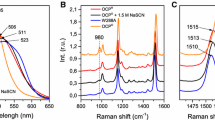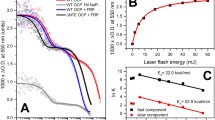Abstract
Photoprotection in cyanobacteria relies on the interplay between the orange carotenoid protein (OCP) and the fluorescence recovery protein (FRP) in a process termed non-photochemical quenching, NPQ. Illumination with blue-green light converts OCP from the basic orange state (OCPO) into the red-shifted, active state (OCPR) that quenches phycobilisome (PBs) fluorescence to avoid excessive energy flow to the photosynthetic reaction centers. Upon binding of FRP, OCPR is converted to OCPO and dissociates from PBs; however, the mode and site of OCPR/FRP interactions remain elusive. Recently, we have introduced the purple OCPW288A mutant as a competent model for the signaling state OCPR (Sluchanko et al., Biochim Biophys Acta 1858:1–11, 2017). Here, we have utilized fluorescence labeling of OCP at its native cysteine residues to generate fluorescent OCP proteins for fluorescence correlation spectroscopy (FCS). Our results show that OCPW288A has a 1.6(±0.4)-fold larger hydrodynamic radius than OCPO, supporting the hypothesis of domain separation upon OCP photoactivation. Whereas the addition of FRP did not change the diffusion behavior of OCPO, a substantial compaction of the OCPW288A mutant and of the OCP apoprotein was observed. These results show that sufficiently stable complexes between FRP and OCPW288A or the OCP apoprotein are formed to be detected by FCS. 1:1 complex formation with a micromolar apparent dissociation constant between OCP apoprotein and FRP was confirmed by size-exclusion chromatography. Beyond the established OCP/FRP interaction underlying NPQ cessation, the OCP apoprotein/FRP interaction suggests a more general role of FRP as a scaffold protein for OCP maturation.







Similar content being viewed by others
Change history
19 September 2017
In Fig. 1a in the original article, the amino acid side chains were incorrectly labeled in the structure representation of the orange carotenoid protein (OCP). The corrected figure is printed in this erratum.
Abbreviations
- OCP:
-
Orange carotenoid protein
- FRP:
-
Fluorescence recovery protein
- NTD:
-
N-terminal domain
- CTD:
-
C-terminal domain
- PBs:
-
Phycobilisome(s)
- FCS:
-
Fluorescence correlation spectroscopy
- EDTA:
-
Ethylenediaminetetraacetic acid
- FM:
-
Fluorescein-5-maleimide
- SEC:
-
Size-exclusion chromatography
- ACC:
-
Autocorrelation curve
- ACF:
-
Autocorrelation function
- OVE:
-
Observation volume element
- R6G:
-
Rhodamine 6G
- DSC:
-
Differential scanning calorimetry
- TCEP:
-
Tris(2-carboxyethyl)phosphin
- GA:
-
Glutaraldehyde
References
Blankenship RE (2014) Molecular mechanism of photosynthesis, 2 edn. Wiley-Blackwell, Oxford, London, Edinburgh
Boulay C, Abasova L, Six C, Vass I, Kirilovsky D (2008) Occurrence and function of the orange carotenoid protein in photoprotective mechanisms in various cyanobacteria. Biochim Biophys Acta 1777(10):1344–1354. doi:10.1016/j.bbabio.2008.07.002
Boulay C, Wilson A, D’Haene S, Kirilovsky D (2010) Identification of a protein required for recovery of full antenna capacity in OCP-related photoprotective mechanism in cyanobacteria. Proc Natl Acad Sci USA 107(25):11620–11625. doi:10.1073/pnas.1002912107
Bryant DA (ed) (1994) The molecular biology of cyanobacteria, Vol 1. Advances in photosynthesis and respiration. Springer, Dordrecht
de Carbon CB, Thurotte A, Wilson A, Perreau F, Kirilovsky D (2015) Biosynthesis of soluble carotenoid holoproteins in Escherichia coli. Sci Rep 5:9085. doi:10.1038/srep09085
Demmig-Adams B, Adams WW (1996) The role of xanthophyll cycle carotenoids in the protection of photosynthesis. Trends Plant Sci 1(1):21–26. doi:10.1016/S1360-1385(96)80019-7
Demmig-Adams B, Garab G, Adams WW III, Govindjee (eds) (2014) Non-photochemical quenching and energy dissipation in plants, algae and cyanobacteria, Vol 40. Advances in photosynthesis and respiration, Springer, Dordrecht
Gorbunov MY, Kuzminov FI, Fadeev VV, Kim JD, Falkowski PG (2011) A kinetic model of non-photochemical quenching in cyanobacteria. Biochim Biophys Acta 1807(12):1591–1599. doi:10.1016/j.bbabio.2011.08.009
Govindjee, Shevela D (2011) Adventures with Cyanobacteria: a personal perspective. Front Plant Sci 2(28):1–17. doi:10.3389/fpls.2011.00028
Gupta S, Guttman M, Leverenz RL, Zhumadilova K, Pawlowski EG, Petzold CJ, Lee KK, Ralston CY, Kerfeld CA (2015) Local and global structural drivers for the photoactivation of the orange carotenoid protein. Proc Natl Acad Sci USA 112(41):E5567–E5574. doi:10.1073/pnas.1512240112
Gwizdala M, Wilson A, Kirilovsky D (2011) In vitro reconstitution of the cyanobacterial photoprotective mechanism mediated by the orange carotenoid protein in Synechocystis PCC 6803. Plant Cell 23(7):2631–2643. doi:10.1105/tpc.111.086884
Gwizdala M, Wilson A, Omairi-Nasser A, Kirilovsky D (2013) Characterization of the Synechocystis PCC 6803 fluorescence recovery protein involved in photoprotection. Biochim Biophys Acta 1827(3):348–354. doi:10.1016/j.bbabio.2012.11.001
Holt TK, Krogmann DW (1981) A carotenoid protein from cyanobacteria. Biochim Biophys Acta (637):408–414. doi:10.1016/0005-2728(81)90045-1
Junghans C, Schmitt F-J, Vukojević V, Friedrich T (2015) Monitoring the diffusion behavior of Na, K-ATPase by fluorescence correlation spectroscopy (FCS) upon fluorescence labelling with eGFP or Dreiklang. Optofluid. Microfluid Nanofluid 2:1–13. doi:10.1515/optof-2016-0001
Kapusta P (2010) Absolute diffusion coefficients: compilation of reference data for FCS calibration. Picoquant GmbH. http://www.picoquant.com/images/uploads/page/files/7353/appnote_diffusioncoefficients.pdf. Accessed 12 June 2015
Kerfeld CA, Sawaya MR, Brahmandam V, Cascio D, Ho KK, Trevithick-Sutton CC, Krogmann DW, Yeates TO (2003) The crystal structure of a cyanobacterial water-soluble carotenoid binding protein. Structure 11(1):55–65. doi:10.1016/S0969-2126(02)00936-X
Kirilovsky D, Kerfeld CA (2012) The orange carotenoid protein in photoprotection of photosystem II in cyanobacteria. Biochim Biophys Acta 1817(1):158–166. doi:10.1016/j.bbabio.2011.04.013
Lakowicz JR (2006) Principles of fluorescence spectroscopy, 3rd edn. Springer, New York
Leverenz RL, Jallet D, Li MD, Mathies RA, Kirilovsky D, Kerfeld CA (2014) Structural and functional modularity of the orange carotenoid protein: distinct roles for the N- and C-terminal domains in cyanobacterial photoprotection. Plant Cell 26(1):426–437. doi:10.1105/tpc.113.118588
Leverenz RL, Sutter M, Wilson A, Gupta S, Thurotte A, Bourcier de Carbon C, Petzold CJ, Ralston C, Perreau F, Kirilovsky D, Kerfeld CA (2015) PHOTOSYNTHESIS. A 12 Å carotenoid translocation in a photoswitch associated with cyanobacterial photoprotection. Science 348(6242):1463–1466. doi:10.1126/science.aaa7234
Liu H, Zhang H, King j D, Wolf NR, Prado M, Gross ML, Blankenship RE (2014) Mass spectrometry footprinting reveals the structural rearrangements of cyanobacterial orange carotenoid protein upon light activation. Biochim Biophys Acta 1837(12):1955–1963. doi:10.1016/j.bbabio.2014.09.004
Liu H, Zhang H, Orf GS, Lu Y, Jiang J, King JD, Wolf NR, Gross ML, Blankenship RE (2016) Dramatic domain rearrangements of the cyanobacterial orange carotenoid protein upon photoactivation. Biochemistry 55(7):1003–1009. doi:10.1021/acs.biochem.6b00013
Magde D, Elson EL, Webb WW (1974) Fluorescence correlation spectroscopy. II. An experimental realization. Biopolymers 13(1):29–61. doi:10.1002/bip.1974.360130103
Majer G, Melchior JP (2014) Characterization of the fluorescence correlation spectroscopy (FCS) standard rhodamine 6G and calibration of its diffusion coefficient in aqueous solutions. J Chem Phys 140(9):094201. doi:10.1063/1.4867096
Maksimov EG, Schmitt FJ, Shirshin EA, Svirin MD, Elanskaya IV, Friedrich T, Fadeev VV, Paschenko VZ, Rubin AB (2014) The time course of non-photochemical quenching in phycobilisomes of Synechocystis sp. PCC6803 as revealed by picosecond time-resolved fluorimetry. Biochim Biophys Acta 1837(9):1540–1547. doi:10.1016/j.bbabio.2014.01.010
Maksimov EG, Klementiev KE, Shirshin EA, Tsoraev GV, Elanskaya IV, Paschenko VZ (2015a) Features of temporal behavior of fluorescence recovery in Synechocystis sp. PCC6803. Photosynth Res 125(1–2):167–178. doi:10.1007/s11120-015-0124-y
Maksimov EG, Shirshin EA, Sluchanko NN, Zlenko DV, Parshina EY, Tsoraev GV, Klementiev KE, Budylin GS, Schmitt FJ, Friedrich T, Fadeev VV, Paschenko VZ, Rubin AB (2015b) The signaling state of orange carotenoid protein. Biophys J 109(3):595–607. doi:10.1016/j.bpj.2015.06.052
Maksimov EG, Moldenhauer M, Shirshin EA, Parshina EA, Sluchanko NN, Klementiev KE, Tsoraev GV, Tavraz NN, Willoweit M, Schmitt FJ, Breitenbach J, Sandmann G, Paschenko VZ, Friedrich T, Rubin AB (2016) A comparative study of three signaling forms of the orange carotenoid protein. Photosynth Res 130(1–3):389–401. doi:10.1007/s11120-016-0272-8
Maksimov EG, Sluchanko NN, Mironov KS, Shirshin EA, Klementiev KE, Tsoraev GV, Moldenhauer M, Friedrich T, Los DA, Allakhverdiev SI, Paschenko VZ, Rubin AB (2017) Fluorescent Labeling Preserving OCP Photoactivity Reveals Its Reorganization during the Photocycle. Biophys J 112(1):46–56. doi:10.1016/j.bpj.2016.1011.3193
Mamedov M, Govindjee, Nadtochenko V, Semenov A (2015) Primary electron transfer processes in photosynthetic reaction centers from oxygenic organisms. Photosynth Res 125(1):51–63. doi:10.1007/s11120-015-0088-y
Mirkovic T, Ostroumov EE, Anna JM, van Grondelle R, Govindjee, Scholes GD (2017) Light absorption and energy transfer in the antenna complexes of photosynthetic organisms. Chem Rev 117(2):249–293. doi:10.1021/acs.chemrev.6b00002
Müller P, Li X-P, Niyogi KK (2001) Non-photochemical quenching. a response to excess light energy. Plant Physiol 125(4):1558–1566. doi:10.1104/pp.125.4.1558
Niyogi KK, Truong TB (2013) Evolution of flexible non-photochemical quenching mechanisms that regulate light harvesting in oxygenic photosynthesis. Curr Opin Plant Biol 16(3):307–314. doi:10.1016/j.pbi.2013.03.011
Punginelli C, Wilson A, Routaboul JM, Kirilovsky D (2009) Influence of zeaxanthin and echinenone binding on the activity of the orange carotenoid protein. Biochim Biophys Acta 1787(4):280–288. doi:10.1016/j.bbabio.2009.01.011
Rigler R, Grasselli P, Ehrenberg M (1979) Fluorescence correlation spectroscopy and application to the study of brownian motion of biopolymers. Phys Scr 19:486–490. doi:10.1088/0031-8949/19/4/030
Sedoud A, Lopez-Igual R, Ur Rehman A, Wilson A, Perreau F, Boulay C, Vass I, Krieger-Liszkay A, Kirilovsky D (2014) The cyanobacterial photoactive orange carotenoid protein is an excellent singlet oxygen quencher. Plant Cell 26(4):1781–1791. doi:10.1105/tpc.114.123802
Shevela D, Pishchalinikov RY, Eichacker LA, Govindjee (2013) Oxygenic photosynthesis in cyanobacteria. In: Srivastava AK, Rai AN, Neilan BA (eds) Stress biology of cyanobacteria. Taylor & Francis, Boca Raton, London, New York
Sluchanko NN, Klementiev KE, Shirshin EA, Tsoraev GV, Friedrich T, Maksimov EG (2017) The purple Trp288Ala mutant of Synechocystis OCP persistently quenches phycobilisome fluorescence and tightly interacts with FRP. Biochim Biophys Acta 1858:1–11. doi:10.1016/j.bbabio.2016.10.005
Sutter M, Wilson A, Leverenz RL, Lopez-Igual R, Thurotte A, Salmeen AE, Kirilovsky D, Kerfeld CA (2013) Crystal structure of the FRP and identification of the active site for modulation of OCP-mediated photoprotection in cyanobacteria. Proc Natl Acad Sci USA 110(24):10022–10027. doi:10.1073/pnas.1303673110
Vukojevic V, Heidkamp M, Ming Y, Johansson B, Terenius L, Rigler R (2008) Quantitative single-molecule imaging by confocal laser scanning microscopy. Proc Natl Acad Sci USA 105(47):18176–18181. doi:10.1073/pnas.0809250105
Vukojevic V, Papadopoulos DK, Terenius L, Gehring W, Rigler R (2010) Quantitative study of synthetic Hox transcription factor-DNA interactions in live cells. Proc Natl Acad Sci USA 107:4087–4092. doi:10.1073/pnas.0914612107
Wilson A, Ajlani G, Verbavatz J-M, Vass I, Kerfeld CA, Kirilovsky D (2006) A soluble carotenoid protein involved in phycobilisome-related energy dissipation in cyanobacteria. Plant Cell 18(4):992–1007. doi:10.1105/tpc.105.040121
Wilson A, Punginelli C, Gall A, Bonetti C, Alexandre M, Routaboul J-M, Kerfeld CA, van Grondelle R, Robert B, Kennis JTM, Kirilovsky D (2008) A photoactive carotenoid protein acting as light intensity sensor. Proc Natl Acad Sci USA 105(33):12075–12080. doi:10.1073/pnas.0804636105
Wilson A, Punginelli C, Couturier M, Perreau F, Kirilovsky D (2011) Essential role of two tyrosines and two tryptophans on the photoprotection activity of the orange carotenoid protein. Biochim Biophys Acta 1807(3):293–301. doi:10.1016/j.bbabio.2010.12.009
Wu YP, Krogmann DW (1997) The orange carotenoid protein of Synechocystis PCC 6803. Biochim Biophys Acta 1322(1):1–7. doi:10.1016/S0005-2728(97)00067-4
Acknowledgements
We thank Agneta Gunnar (Karolinska Institutet Stockholm) for technical support and Dr. Maria Schlangen-Ahl (Organic Chemistry Department of TU Berlin) for support in mass spectrometry. This work was supported by travel grants within the COST MP1205 framework to C. J., the Knut and Alice Wallenberg Foundation (KAW 2011.0218) and the Foundation for Strategic Research (SBE13-0115) to V.V., the German Ministry for Education and Research (WTZ-RUS grant 01DJ15007 to T.F.), and the German Research Foundation (Cluster of Excellence “Unifying Concepts in Catalysis” to T.F.). E.G.M. thanks the Russian Foundation for Basic Research (Project No. 15-04-01930A), the Russian Ministry of Education and Science (project MK-5949.2015.4), the Dynasty Foundation Fellowship, RFBR, and Moscow City Government according to the research project No. 15-34-70007 «mol_а_mos» for partial support of this work. N.N.S. was supported by a scholarship from the President of Russian Federation (SP-367.2016.4).
Author information
Authors and Affiliations
Corresponding author
Ethics declarations
Conflict of interest
The authors declare that there are no conflicts of interest.
Additional information
An erratum to this article is available at https://doi.org/10.1007/s11120-017-0445-0.
Electronic supplementary material
Below is the link to the electronic supplementary material.
Rights and permissions
About this article
Cite this article
Moldenhauer, M., Sluchanko, N.N., Tavraz, N.N. et al. Interaction of the signaling state analog and the apoprotein form of the orange carotenoid protein with the fluorescence recovery protein. Photosynth Res 135, 125–139 (2018). https://doi.org/10.1007/s11120-017-0346-2
Received:
Accepted:
Published:
Issue Date:
DOI: https://doi.org/10.1007/s11120-017-0346-2




